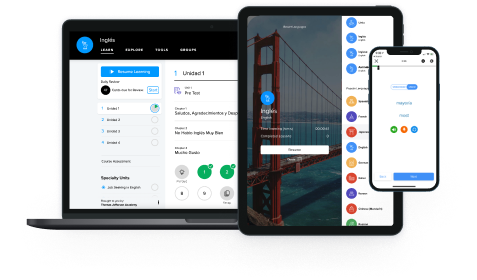Remember that “normal” non-subjunctive verbs are called “indicative” verbs. We’ll use this term below, to contrast these two .

The Subjunctive I in German: What is it and how to use it?
In German, the subjunctive I is used mainly in written language to report what someone said or did while allowing some uncertainty about whether what they said was true. You’ll see a lot of the subjunctive I used a lot in the German news, whether you read newspapers or listen to podcasts. For example:
Taylor Swift sagte, sie habe hart an dem neuen Album gearbeitet.
Taylor Swift said that she worked hard on the new album.
In this article, we'll take a closer look at the subjunctive I (Konjunktiv I) in German. We’ll go through how to form it in different tenses, how to use it, and discuss some cases where you should use other forms of the verb instead. Let’s have a look!
The German subjunctive: Subjunctive I vs. subjunctive II
In German, there are two forms that we call “the subjunctive”: the subjunctive I and the subjunctive II. Both used for the same broad purpose: to show some level of speculation or uncertainty about whether an action happened, will happen, or is happening.
In most contexts, you’ll probably use the subjunctive II. It’s more common, less formal, and can be used in a wider range of situations.
Experts say that interest rates will fall this year.
So, though the subjunctive II may be more common, it’s important to learn to form and use the subjunctive I as well!
Tip
How to form the subjunctive I in German?
The rules for forming the subjunctive I depend on the tense of the verb. You can use this mood in the present tense, past tense, future tense, and future perfect tense. The ones that you will come across most of the time are present and past, but we’ll still take a look at how to form all four of them.
Subjunctive I: Present tense
To form the present tense in the subjunctive I, you’ll just use the regular present tense verb endings (-e, -st, -t, -en, -t, -en). The only differences are:
you’ll add an -e between the ending and the in the “you” forms (du and ihr)
the ending of the er/sie/es(he/she/it) form is just -e (not -t)
Compare the present subjunctive I and the present indicative of the verb machen(to make, do)
Present tense | |
|---|---|
Subjunctive I | Indicative |
ich mache | ich mache |
du machest | du machst |
er/sie/es mache | er/sie/es macht |
wir machen | wir machen |
ihr machet | ihr macht |
sie/Sie machen | sie/Sie machen |
For example:
Harry sagte nach der Schule, er mache jetzt seine Hausaufgaben.
After school Harry said he was now doing his homework.
Exception!
This conjugation rule applies to all verbs except for–you might have already guessed it as this one is usually the odd one out – sein(to be). Take a look at its conjugation table below.
sein(to be) | |
|---|---|
ich sei | wir seien |
du sei(e)st | ihr sei(e)t |
er/sie/es sei | sie/Sie seien |
Note that in the “you” forms (du and ihr) the -e- is optional. The forms with the e are a little old-fashioned, but you can still come across both versions today.
Subjunctive I: Past tense
The past subjunctive I is pretty straight forward. You use the subjunctive I form of the auxiliary verbs haben(to have) or sein(to be) and the past participle.
haben / sein
present subjunctive I
past participle
main verb
Harry sagte, er habe laut über Rons Witz gelacht.
Harry said he laughed hard at Ron’s joke.
Harry sagte, er sei gestern zu Hagrid gegangen.
Harry said that he went to Hagrid’s yesterday.
By now these pieces are probably familiar to you, but if you need to review, check out our posts on choosing between haben and sein and on past participles in German!
Let’s look at a couple examples: lachen(to laugh)and gehen(to go, walk).
lachen(to laugh) | |
|---|---|
ich habe gelacht | wir haben gelacht |
du hab(e)st gelacht | ihr hab(e)t gelacht |
er/sie/es habe gelacht | sie/Sie haben gelacht |
gehen(to go, walk) | |
|---|---|
ich sei gegangen | wir seien gegangen |
du se(e)st gegangen | ihr seiet gegangen |
er/sie/es sei gegangen | sie/Sie seien gegangen |
Subjunctive I: Future & Future Perfect
When you form the subjunctive I in the future or future perfect, you’ll need to use the present subjunctive I form of the auxiliary verb werden(will, to become)
Future Subjunctive I:
werden
present subjunctive Iinfinitive
main verbHarry erzählte mir, er werde am Montag seinen neuen Besen bekommen.
Harry told me that he would get his new broom on Monday.
Future Perfect Subjunctive I:
werden
present subjunctive Ipast participle
main verbhaben / sein
infinitiveHarry erzählte mir, er werde bis Montag seinen neuen Besen bekommen haben.
Harry told me that he would get his new broom on Monday.
For reference, please see a full conjugation table of werden(will; to become) in subjunctive I below:
werden(will; to be ) | |
|---|---|
ich werde | wir werden |
du werdest | ihr werdet |
er/sie/es werde | sie/Sie werden |
When to use the subjunctive I in German?
In German, you’ll most often use the subjunctive I in indirect reported speech, particularly in writing.
Indirect speech is used to report on the message of what someone said or thought, without necessarily using their exact words. An example in English might be, “Marcus said he wasn’t coming.” Notice that we understand that Marcus literally said something like “I’m not coming,” but here we aren’t reporting his exact words, so this is indirect reported speech.
In German, indirect reported speech involves two parts:
a , containing a verb of reporting sagen(to say), berichten(to report), or erklären(to explain).
a , containing the reported speech.
Let’s look at an example. Let’s say you’re a reporter and you hear the Foreign Secretary say:
“Ich muss handeln!”
“I have to act!”
When you go to report on her statement in your article, you might report this statement using one of the statements below:
Die Außenministerin sagte, sie müsse handeln.
The Foreign Secretary said she has to act.
Die Außenministerin sagte, dass sie handeln müsse.
The Foreign Secretary said that she has to act.
Because it’s not a direct quote and because you’re writing, you’ll use the subjunctive I. There are two important things to note:
The tense of the original quote is preserved: present indicative → present subjunctive I. If the original quote contained the past tense, then you might use the past subjunctive I instead.
Why are there two versions of the reporter’s sentence? There are two versions because the conjunction dass(that) is optional in German just like in English. Both versions are common. The only thing to be careful of is the word order — as with other subordinate clauses in German, the addition of the conjunction “kicks” the conjugated verb (in this case müsse) moves to the end of the sentence.
When to avoid using the subjunctive I in reported speech?
Though the subjunctive I is commonly used in written indirect reported speech, there are two main contexts where you should avoid using this form of the verb:
In everyday spoken German, you’re more likely to use the subjunctive II in indirect speech. In some casual contexts you might even hear the indicative!
When first or second person subject (I, you, we) said, the subjunctive I is also uncommon. Germans prefer one of these options instead:
würde(would) + infinitive
subjunctive II
Using these other forms helps to better distinguish the subjunctive form from the indicative form.
For a lot more discussion about how to pick the right verb form to use in indirect reported speech, check out our in-depth post on reported speech in German!
What are other uses of subjunctive I in German?
In addition to being used in reported speech, the subjunctive I can also be used to give commands, directions or instructions in writing. You can find this in:
Recipes and cookbooks:
Man nehme 200g Mehl und 50g Zucker und verrühre beides gut.
Take 200g flour and 50g sugar and mix well.
Technical language (e.g., mathematics or instruction manuals):
Hier sei eine Zahl größer als 20…
Let’s take a number bigger than 20…
lit. Here is a number bigger than 20.
Historic/religious context, fiction:
Es lebe die Königin!
Long live the Queen!
Möge die Macht mit Euch sein!
May the force be with you!
What are some idioms and phrases using subjunctive I in German?
In German, a few idioms and set phrases always use the subjunctive I. Two of the most common ones are:
es sei denn(unless):
present subjunctive IPaul wird morgen wandern gehen, es sei denn es regnet.
Paul is going to go hiking tomorrow unless it rains.
so sei es(so be it):
present subjunctive I“Neun Gefährten. So sei es. Ihr bildet die Gemeinschaft des Rings!”
“Nine companions. So be it. You shall be the fellowship of the ring!"
Summary
In this post, we’ve introduced you to the German subjunctive I. Here are the important points to remember:
The subjunctive I is used primarily for indirect reported speech, specifically in written language (e.g., in news reports)
Use the same tense in the subjunctive I that the original quote used: present, past, future and future perfect. The tenses that are most frequently used in the subjunctive I are present and past.
Present → Looks mostly like the present indicative, but the “you” and “he/she/it” forms have e’s added
Past → Formed using the present subjunctive I of haben/sein + past participle
You will rarely ever hear the subjunctive I in spoken German, the subjunctive II is much more common there.
Ready to review? Try out our German subjunctive I practice exercises. Happy learning!
